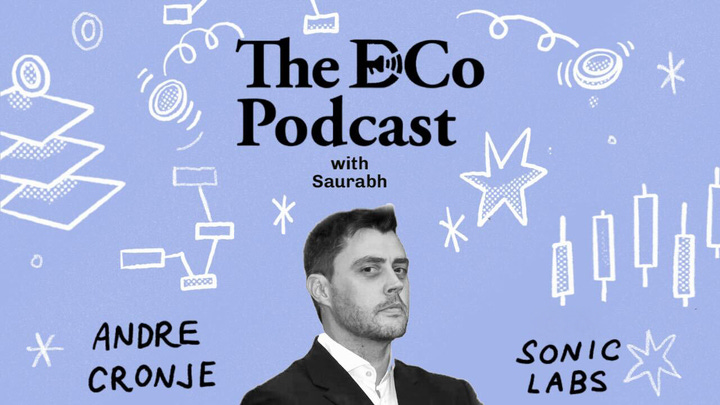Abstracting Away Blockchain ⛓️
Mastering the art of balancing decentralisation and usability
Hello!
Every Saturday, I dive into a podcast hosted by our partners at Decentralised.co and share what caught my attention.
This week, I reflected on the episode where Sonic Labs’ CTO Andre Cronje joined Saurabh Deshpande to unpack how builders in the Web3 space need to handle the dilemma between decentralisation and usability.
Listen to the full episode here.
"Journalism isn't about showing off our vocabulary prowess. We are here to tell stories in a way that helps people make sense of what's happening in the world of business." That's what my editor at the first business newsroom I worked in would tell me each time she corrected my copy of all the jargon I'd use as a fresher.
Andre’s thoughts around the decentralisation-usability dilemma reminded me of my early days as a business reporter. I found it criminal to use simpler vocabulary to tell stories in a field that demanded special expertise of how the economy and numbers worked.
But my editor would remind me of the bigger picture. I learnt the lesson gradually. A similar dilemma has forever been brewing in the builders’ ecosystem in the DeFi world. How to choose between building products in a truly decentralised approach and building for usability by masses? Or should they even choose one.
A “truly decentralised” approach, while desirable by the “techno anarchists”, would be a disastrous way to build a business. It would require users to know about their operating system, be able to run software, sync it, execute complex transactions and more.
That would alienate customer experience so much so that the eventual total addressable market (TAM) for such DeFi projects would be just two users, Andre corrects Saurabh with an even conservative number, when he says “10,000”.
The tension between ideological purity and practical adoption reminds me of a story I read a couple of days back about Japan's train stations, where NBA Top Shot NFTs are now sold through vending machines. Users scan a QR code, create a Flow wallet automatically, and purchase basketball highlight collectibles using Apple Pay or Google Pay — all without knowing they're interacting with blockchain technology.
For 1,000 yen (roughly $7.18), anyone can own a piece of blockchain-based sports history. No wallet management, no gas fees, no private key anxiety.
This is the kind of "centralised hack" that Andre acknowledges we're using today to bridge the usability gap. The wallet creation is automated, the complexity is abstracted away, and users engage with Web3 without realising it. It works, but it comes at the cost of the decentralisation ideals that originally inspired the technology.
Personally, I am happy with these “hacks” as long as they help me buy a digital collectible from a vending machine or for other similar experiences. But as the value increases, I want to be sure that the system I’m using to hold and transport that value is rock solid.
The debate of purity and usability comes alive when we start talking about projects that could bring blockchain benefits to millions more people. Blockchain primitives nowadays are increasingly designed with user-friendly features that compromise their foundational qualities of composability and immutability.
Think of primitives as digital Lego blocks or basic building pieces that developers use to construct more complex applications atop them. Immutability means these blocks can't be changed once they're placed (imagine Lego blocks carved from stone), whilst composability ensures different blocks from different sets can fit together seamlessly.
Andre's concern is that modern projects are abandoning these qualities in favour of better user experiences. They're building with blocks that can be reshaped at will or don't follow standard connection patterns.
Would it be as much fun if Legos pieces across geographies and different eras of time didn’t fit together?
Unlock Web3 Insights with Decentralised.co
Long-form stories trusted by the best in Web3. Senior executives from 140+ enterprises trust them to keep them updated on what's going on in crypto.
Good writing. In-depth conversations. Right in your inbox.
Subscribe to Decentralised.co
The DeFi world boasts of compatibility as one of its prime strengths. This is why Andre’s concern is warranted. Primitives trading off composability and immutability for usability creates serious problems when other developers try to build on top of them. "Everyone feels a lot more siloed than ever before," Andre says. "Everyone's kind of ring fencing their own little thing."
There’s a reason why the builders today choose to move away from the purity of decentralisation. Andre even acknowledges this: “probably 90% (of today’s users) are not techno-anarchists or any kind of techno-aligned."
And they most certainly wouldn’t be. Masses expect convenience from a new technology or innovation. Not, more complications. Would we have switched to Google Pay and Venmo if it still required us to add the bank details of the recipient and wait for some more checks to be done before we could transfer some funds?
I don’t think a majority of people who switch from traditional finance to DeFi products, such as payments or loans, do so because they believe in the principles of decentralisation. They simply want a better experience: undercollateralised loans, low-cost and quicker payments and faster loan disbursements.
Andre’s case for maintaining certain principles, particularly around primitives, creates a paradox. The most successful decentralised protocols succeed precisely because they sacrifice flexibility for predictability. They become digital infrastructure that others can confidently build upon, but only by accepting that they can never fundamentally change.
Andre's frank assessment that "decentralisation and user experience are 100% at odds with each other", makes the scenario sound defeatist. Yet it's honest. This doesn't mean we should abandon decentralisation entirely.
Listen to the full episode here.
What’s the way out then?
The Japanese vending machine experiment offers a glimpse of what this evolution might look like for blockchain. Users get true ownership of their digital collectibles, backed by immutable smart contracts, but they don't need to understand Merkle trees to participate.
The goal for the builders in the space should not be to remove blockchain technology itself, but to make it as invisible as the transmission of a video over the internet — compressed, broken into packets, transmitted and then reassembled at the destination. This is abstraction done right: preserving the powerful underlying properties of decentralised systems while making them accessible to the 90% of users who simply want things to work.
That’s it for this week’s reflections.
I’ll see you next week.
Off to find a vending machine that sells crypto without crypto,
Prathik
Token Dispatch is a daily crypto newsletter handpicked and crafted with love by human bots. If you want to reach out to 200,000+ subscriber community of the Token Dispatch, you can explore the partnership opportunities with us 🙌
📩 Fill out this form to submit your details and book a meeting with us directly.
Disclaimer: This newsletter contains analysis and opinions of the author. Content is for informational purposes only, not financial advice. Trading crypto involves substantial risk - your capital is at risk. Do your own research.







